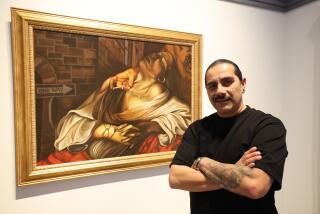Michelangelo’s Sistine Chapel frescoes linked to the golden ratio

A new study claims that Michelangelo used the golden ratio when painting the Sistine Chapel.
Michelangelo likely used a famous mathematical ratio to paint “The Creation of Adam” and other frescoes on the ceiling of the Sistine Chapel, a recently published study claims.
The article published this month in the journal Clinical Anatomy states that the Renaissance artist may have employed the so-called “golden ratio” -- a proportion often associated with physical efficiency and that frequently occurs in nature -- to create the 16th century masterpiece.
Like many artists of his period, Michelangelo was fascinated by human anatomy and likely studied cadavers to enhance his knowledge of the human form.
Essential Arts & Culture: A curated look at SoCal’s vast and complex arts world
For the study, researchers and scholars from Brazil used digital software to analyze “The Creation of Adam,” which was commissioned by Pope Julius II and is located at the Vatican.
The golden ratio asserts that for two lines of unequal length, the ratio between the longer length and shorter length is equal to the ratio between the sum of the two lengths and the longer length. In other words, if “a” is the shorter line and “b” is the longer line, then (b/a) = ((a+b)/b)).
In the study, researchers used the length just beyond Adam’s left-most shoulder and the foot of God. The point separating the length into two unequal lines is the point at which the two figures nearly touch fingers.
“The fingers of God and Adam do not touch, because this is where there is an interruption, constituting the dividing line of the Golden Ratio,” the study says. The article concludes that dividing the length in such a manner adheres to the ratio, suggesting that Michelangelo designed the fresco with the mathematical rule in mind.
The article states that the shorter line is approximately 2.2 meters in length while the longer line is about 3.6 meters.
In addition, the study found that the fingers of God and Adam are aligned with other images on the ceiling of the Sistine Chapel in accordance to the golden ratio, which is also known as the “divine proportion.”
“The result of this analysis is astounding,” the article states.
Michelangelo is believed to have created the frescoes on the ceiling of the Sistine Chapel between 1508 and 1512.
“We believe that in all probability, Michelangelo knew that anatomical structures incorporating the Golden Ratio offer greater structural efficiency and, therefore, used the Golden Ratio to enhance the aesthetic quality of his works,” the article says.
The golden ratio is often associated with Leonardo Da Vinci, who is thought to have used the mathematical rule in frescoes, including “The Last Supper,” and engineering drawings.
Like the number pi, the golden ratio, which is often referred to as phi, has digits that are thought to extend into infinity, though it is often rounded to 1.618.
Twitter: @DavidNgLAT
More to Read
The biggest entertainment stories
Get our big stories about Hollywood, film, television, music, arts, culture and more right in your inbox as soon as they publish.
You may occasionally receive promotional content from the Los Angeles Times.







